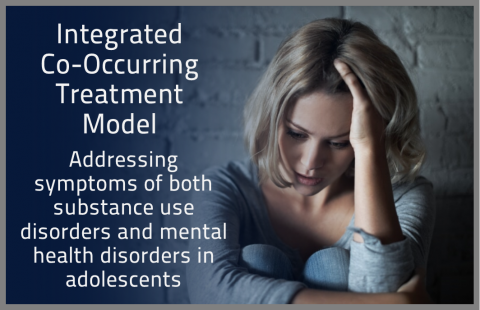Integrated Co-Occurring Treatment Model (ICT) is an integrated treatment approach embedded in an intensive home-based method of service delivery, providing a core set of services to youth with co-occurring disorders of substance use and serious emotional disability, as well as providing services to the families caring for them.
ICT providers work with adolescents ages 12 to 17.5 – youth exhibiting co-occurring mental health and substance use disorders – while also providing intervention that impacts the contextual factors that are affected by the youth’s co-occurring disorders. Thus, ICT requires both youth and family participation which means at least one parent/guardian needs to be involved in the intervention process.
The ICT model is designed to provide clinicians with a process and framework for organizing information in order to assess, conceptualize, and intervene in a coordinated and integrated fashion. In addition, ICT focuses on assisting the clinicians with the positive engagement and retention of youth and families, as well as better recognition of family culture and contexts. ICT also aids clinicians, program leaders, and relevant stakeholders in creating realistic service expectations, in the process decreasing clinician frustration, burnout, and fatigue when dealing with a challenging population.
The ICT model has proven successful in improving treatment outcomes for youth and families, the outcomes including:
- Decreased substance use disorder symptoms
- Decreased mental health disorder symptoms
- Decreased juvenile justice charges and placements
- Decreased out-of-home placements
- Improved school functioning
- Improved family functioning
- Improved community functioning and involvement
ICT Background
In the fall of 1999, with the support of the Ohio Department of Mental Health (ODMH) and the Center for Family Studies at the University of Akron convened a group of state, university, and community experts (including youth and families) to develop an integrated treatment program especially designed for adolescents with co-occurring disorders and their families.
The guidelines for the model development were that services had to include a system of care service philosophy, including the centrality of partnerships with youth and family, as well as the following components:
- Cultural mindfulness
- Integrated treatment approach
- Home-based intervention service delivery mechanism
- Developmentally appropriate
- Components that are grounded in prior empirical research
- Theoretically and conceptually driven
Role of CIP
In 2005, the Center for Family Studies developed a partnership with the Center for Innovative Practices (CIP) to disseminate ICT and to further develop and refine the model.
The Center for Innovative Practices is one of the Ohio Department of Mental Health’s Coordinating Centers of Excellence. As of July 2007, the Center for Innovative Practices is the central location for the development, dissemination, and future research on ICT.
Recently, ICT was recognized nationally as a promising program model in the Blueprint for Change: A Comprehensive Model for the Identification and Treatment of Youth with Mental Health Needs in Contact with the Juvenile Justice System (The National Center for Mental Health and Juvenile Justice, 2007).
Currently, ICT is being implemented in four sites nationally. These sites are located in Akron, Ohio; Cuyahoga County, Ohio; Kalamazoo, Michigan; and McHenry County, Illinois. A past ICT site is located in Salinas, California.
ICT Treatment Brief
The central goals of ICT for the individual are risk reduction, appropriate developmental functioning in major life domains, symptom reduction, improved family functioning, relapse prevention, and ongoing recovery and resilience. A co-occurring disorder exists when an individual experiences mental and substance use disorders at the same time. Although these disorders may exist independently, they interact within the individual to the extent that one exacerbates the other. In youth with co-occurring disorders, this interaction underpins the complexity of symptom patterns and behaviors, which adversely affects youth’s functioning in developmentally important life domains. To further complicate matters, the presence of co-occurring disorders in youth, particularly substance use, impacts brain development. Contextual factors – such as peers, family, school, neighborhood, and the risk and protective factors associated with them – play a mediating role in youth behaviors, use patterns, and the recovery trajectory. As a result, youth with co-occurring disorders are an extremely diverse group, making sustained recovery a significant challenge.
The ICT core treatment components consist of:
- Providers embodying a system of care service philosophy, including ongoing collaboration, persistence, and engagement of the youth and family
- Interventions that are rooted in an intensive home-based service delivery model
- Services utilizing an integrated treatment and case conceptualization process designed to increase clinicians’ ability to provide the appropriate level of intensity, integration, and balance when delivering interventions to youth with co-occurring disorders.
Additional ICT Resources
Journal of Dual Diagnosis, 2004, co-authored by Richard Shepler, PhD, PCC-S: The Integrated Co-Occurring Treatment (ICT) Model: A Promising Practice for Youth with Mental Health and Substance Abuse Disorders
SAMHSA (Substance Abuse and Mental Health Services Administration): Integrated Treatment for Co-Occurring Disorders, The Evidence. This resource introduces all stakeholders to the research literature and other resources on Integrated Treatment for Co-Occurring Disorders. This booklet includes the following: two key resources included in the KIT, additional resources for further reading, and references for the citations presented throughout the KIT.
2013 brief authored by Patrick Kanary, MEd; Richard Shepler, PhD, PCC-S; and Michael Fox, MA, PCC-S, LCDC-III: Providing Treatment for Youth with Co-occurring Disorders; Advancing Juvenile Drug Treatment Courts: Policy and Program Briefs.
Contact
Michael Fox, MA, PCC-S, LCDC III


